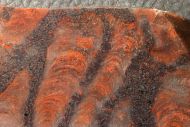Fossils for sale
Welcome back!
Sold:
Stromatolith Collenia undosa Walcott 1916
Products description
| This is an exceptionally beautiful stromatolite slab from the early Precambrian of the United States. It features a polished section of Collenia undosa, extracted from approximately 2.2 billion-year-old banded iron formations (BIFs) of the Biwabik Iron Formation in Minnesota. A particularly striking aspect of this slab is its diverse array of microfossils. Due to the somewhat opaque nature of the specimen, these fossils can be observed even without thin-section preparation. Among the possible species are Gunflintia grandis (Barghoorn, 1965) and Eosphaera tyleri (Barghoorn, 1965). The Biwabik Formation, along with the contemporaneous Gunflint Formation, has yielded a remarkably rich community of ancient microorganisms. It is fascinating to witness how early biological diversity emerged in Earth’s history and how it can be evidenced through scientific study even today. The Site of the Mary Ellen Mine is a classical Banded Iron Formation. Locality. It is knon and valoured for its nice and colourfully preservation. These decorative Stromatolite fossils are sometimes even used for jewellery. The Cyanobacteria that where incorporated in the bounding of this Stromatolite have likely produced significant amounts of oxygen. This free oxygen bond the FeČ that was solved in the ancient oceans. This process produced the Banded Iron Formations (also known as BIF’s ) world wide at that time in earth history. After all the iron was used up by that process the oxygen concentrations in the Atmosphere and ocean could rise. What lead to the great oxygen crisis (sometimes also known as the first big extinction). How ever the higher levels of oxygen allowed the life eventually to become more complex. | |||
Location: | Mary Ellen Mine, Mesabi Range, St. Louis County, Minnesota, USA | ||
| Size : | about 94 x 110 mm | ||
| Age: | Precambrian, Lower Proterozoic, Rhyacian, Biwabik Formation (about 2.2 Ga / 2200 Ma) | ||
Product no.: 11812















